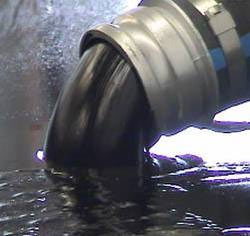Oil-hauling supertankers are bracing for the worst earnings year since 2013 as they become collateral damage in OPEC’s quest to trim a global glut of crude.
So-called very large crude carriers, 1,200-foot vessels each hauling 2 million barrels, will earn an average of $25,000 a day next year, according to the median of eight shipping analysts surveyed by Bloomberg. That’s 12 percent lower than they were anticipating before the Organization of Petroleum Exporting Countries took a decision on Nov. 30 to cut collective output by enough to fill four ships a week.
“This can lead us back to the market in 2013,” said Frode Morkedal, an analyst at Clarksons Platou Securities, the investment banking unit of the world’s largest ship broker. If OPEC carries out its planned cuts of 1.2 million barrels a day, “rates will crash because it will lead to higher oil prices, lower demand and less trade.”
The tanker market’s worsening prospects are just one of the knock-on effects after OPEC’s agreement, which is supposed to start in January and last for an initial six months. The accord caused a surge in oil prices, making life more expensive for anyone who buys or transports fuel — including American motorists, Indian refiners, airlines and shippers. It’s also likely to give a boost to U.S. shale-region producers and to deter some traders from storing oil at sea.
The downgraded outlook for tanker earnings wasn’t unexpected. Before the meeting, several shipping analysts said they were planning cuts of their own in case OPEC reduced output. Shares of Euronav NV of Antwerp and Bermuda-based DHT Holdings Inc. are trading below or near their levels just prior to the accord’s announcement. Those of Frontline Ltd. in Oslo have recovered from their drop after Nov. 30.
Declining rates
The day after OPEC’s meeting, Pareto Securities AS moved Euronav and DHT to a “hold” rating and Frontline to a “sell”. Morkedal of Clarksons said he didn’t expect those companies to suffer significantly from OPEC’s action because “they have improved their balance sheets and have cash break-even levels at or below $20,000 a day.”
In 2015, amid an oil-price slump created by a glut of crude worldwide, supertankers had a banner year, earning an average of $64,846 a day on international hauls, according to estimates from Clarkson Research Services Ltd. Daily returns fell to $40,281 this year. In 2013, when crude prices in New York topped $110 a barrel, supertanker rates averaged $18,621 a day.
As many as 14 non-OPEC nations, including Russia, are scheduled to meet with the producer group this weekend in Vienna to discuss further output reductions of as much as 600,000 barrels a day. What remains to be seen is whether U.S. production, expected to rise as the OPEC accord lifts crude prices, will fill the gap, and which tankers would move any extra barrels.
Additional cuts
Because of the location of OPEC’s key producers — Saudi Arabia, Iraq, Iran, the United Arab Emirates and Kuwait — the group’s output cuts will primarily affect Middle Eastern grades of crude.
Daily rates this week on a benchmark route from the Middle East to Asia have actually risen each day this week, closing at $51,775 Wednesday. Rising crude imports in China, which is receiving an increasing amount of oil from the Atlantic region, is helping to boost tanker demand, according to a research note from Arctic Securities AS on Thursday.
Indeed, not all analysts surveyed by Bloomberg after the output accord have taken a pessimistic outlook for oil tankers next year. Fearnley Securities AS is among those maintaining its previous forecast for supertanker rates.
“We already expected lower oil production growth next year, and the loss of volumes overall could to some extent be offset by a longer distance trade from the Atlantic to the Far East for tankers,” Fearnley analyst Jonathan Staubo said by phone.
The survey of rate forecasts used for this story was based on contributions from analysts whose estimates reflected their views in the wake of OPEC’s Nov. 30 decision. A separate survey, with a wider pool of estimates, will be published at a later date.
Source: Bloomberg.
